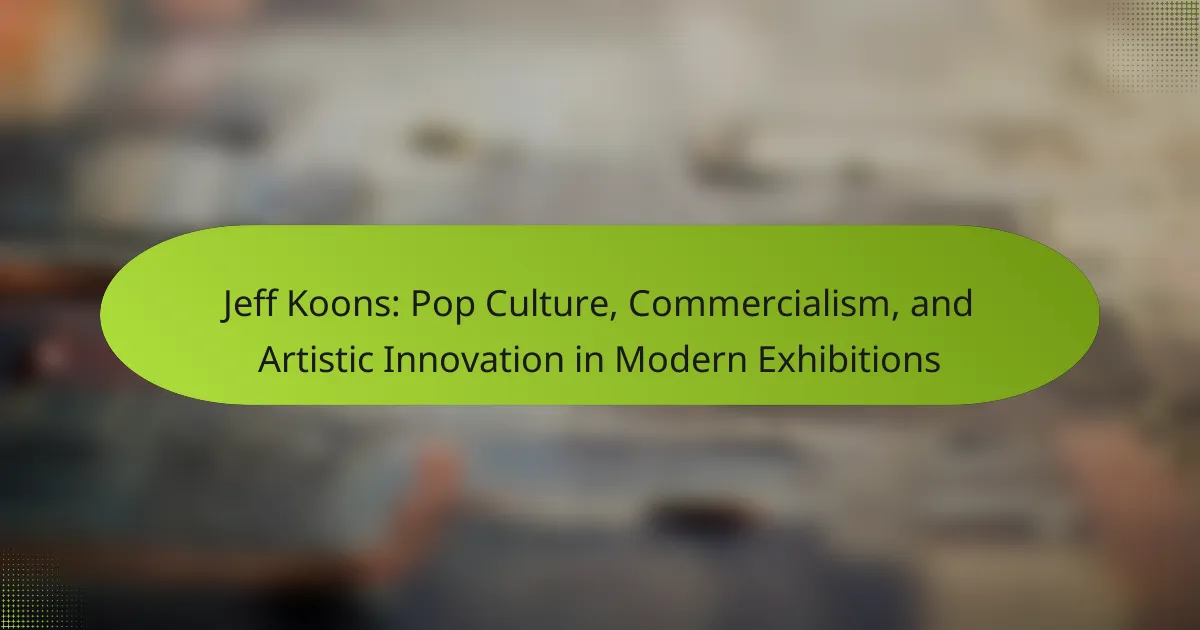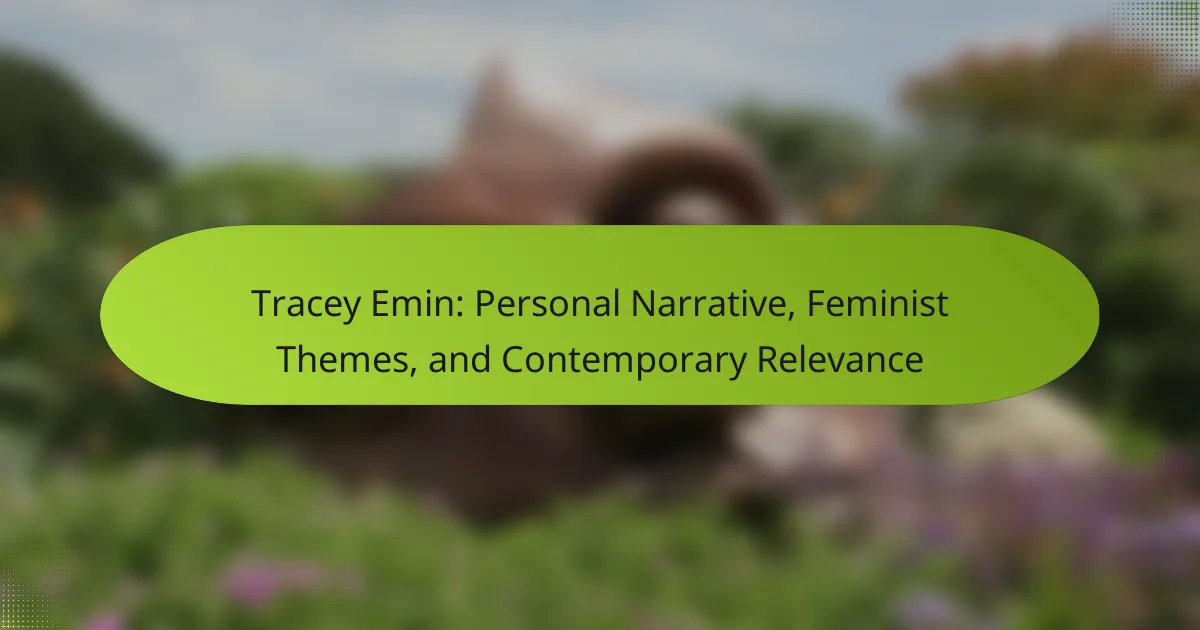Anish Kapoor’s sculptures transform viewer engagement through immersive experiences and spatial manipulation. His reflective surfaces challenge perceptions of reality, inviting interaction and contemplation. Kapoor’s innovative use of materials creates dynamic sensory experiences that redefine contemporary art. His influence extends to redefining the relationship between sculpture and space, prompting deeper emotional connections with audiences.
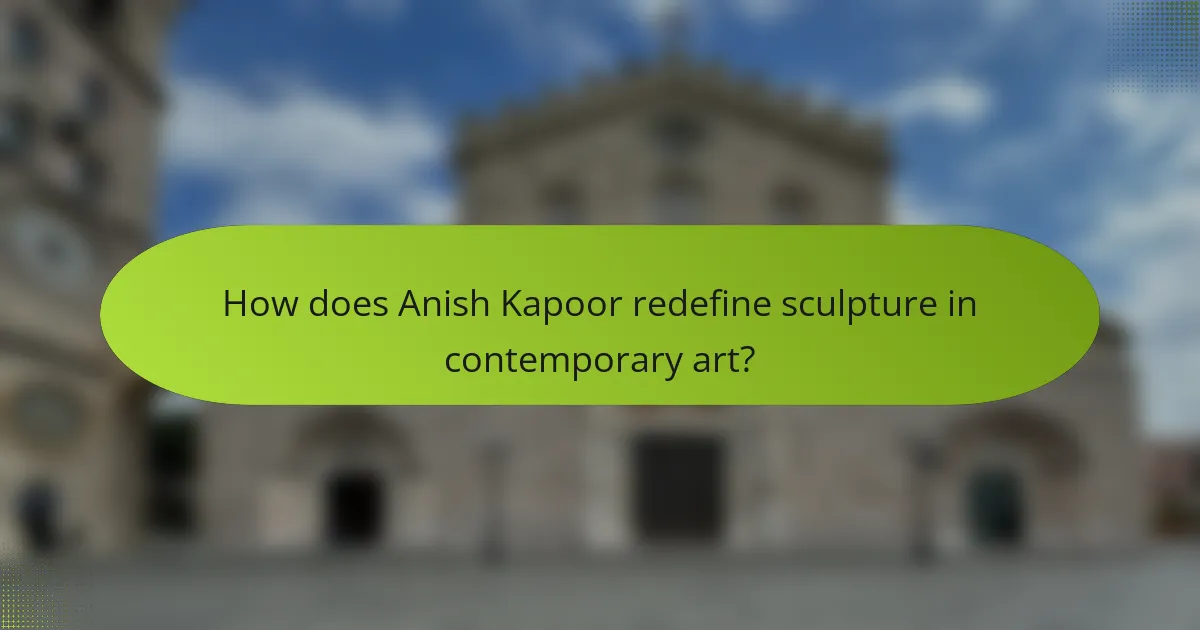
How does Anish Kapoor redefine sculpture in contemporary art?
Anish Kapoor redefines sculpture by engaging viewers through immersive experiences and manipulating space. His works often challenge perceptions of reality, inviting interaction and contemplation. Kapoor’s use of reflective surfaces, such as in “Cloud Gate,” creates a dialogue between the artwork and its environment. This unique approach transforms traditional notions of sculpture into dynamic sensory experiences, emphasizing the relationship between the observer and the observed. His innovative techniques and materials push the boundaries of contemporary art, making his sculptures not just objects but experiences that redefine space and perception.
What are the core themes present in Kapoor’s works?
Anish Kapoor’s works explore themes of space, perception, and the sensory experience of art. His sculptures often challenge viewers’ understanding of form and materiality. Kapoor integrates light and shadow, creating dynamic interactions within the environment. Unique attributes include the use of reflective surfaces, which distort and amplify surroundings, enhancing viewer engagement. The interplay of voids and masses in his installations evokes a sense of mystery and introspection.
Which materials and techniques does Kapoor commonly use?
Anish Kapoor commonly uses materials such as stone, metal, and resin, employing techniques like casting, polishing, and layering. His work often explores the interplay between form and space, creating immersive sensory experiences. Kapoor’s unique use of reflective surfaces, particularly in pieces like “Cloud Gate,” enhances viewer interaction and perception. He also integrates rare materials, such as pigment-infused wax, to evoke emotional responses.

In what ways does Kapoor’s work engage with space?
Anish Kapoor’s work engages with space by transforming environments and altering perceptions. His sculptures often create immersive experiences that challenge viewers’ understanding of dimensions. For example, the installation “Sky Mirror” reflects the surrounding sky, blurring the boundaries between sculpture and nature. Kapoor’s unique use of materials, such as polished stainless steel, enhances the interaction with light and space, creating dynamic visual effects. Additionally, his installations frequently invite audience participation, further deepening the sensory experience of spatial engagement.
How do Kapoor’s installations alter the viewer’s perception of space?
Kapoor’s installations transform viewer perception by manipulating space and sensory experience. His works often create immersive environments that challenge conventional spatial relationships. For example, the reflective surfaces in “Cloud Gate” distort reflections, altering how viewers perceive their surroundings. This interaction encourages introspection and a re-evaluation of personal space. Kapoor’s unique use of scale and material further enhances this effect, making the viewer acutely aware of their position within the installation.
What role does scale play in Kapoor’s sculptures?
Scale significantly influences Anish Kapoor’s sculptures by altering perception and interaction. Large-scale works create immersive environments, inviting viewers to engage physically and emotionally. The monumental size often evokes a sense of awe, challenging spatial boundaries. Kapoor’s unique attribute of manipulating scale enhances the sensory experience, making each piece a transformative encounter.
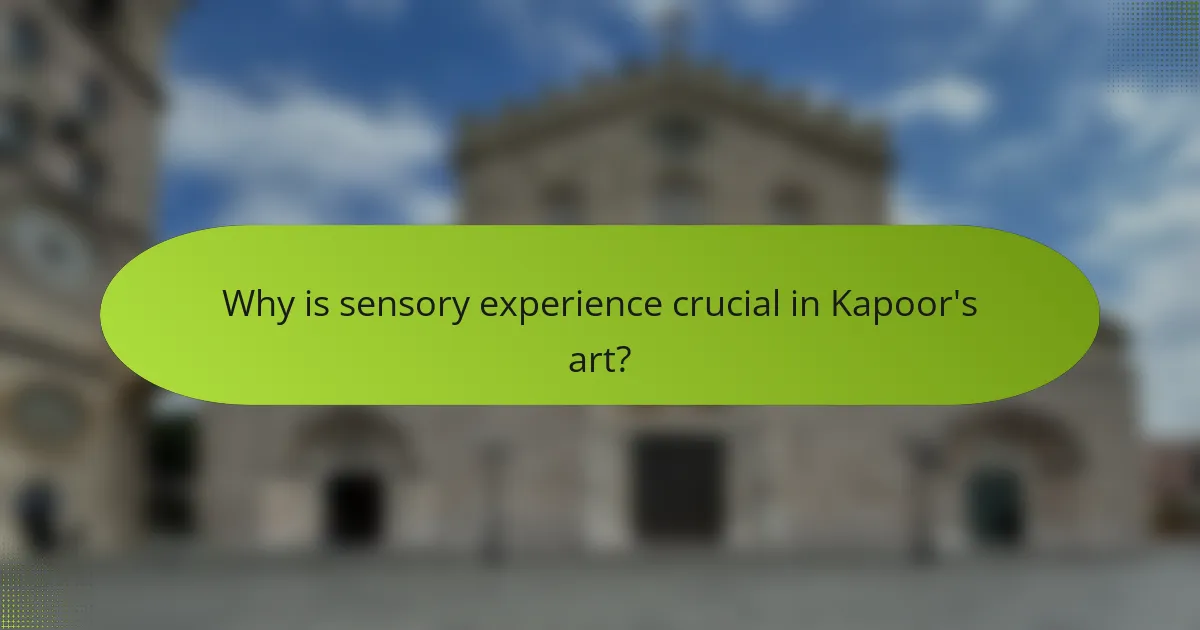
Why is sensory experience crucial in Kapoor’s art?
Sensory experience is crucial in Kapoor’s art because it engages viewers on multiple levels. His sculptures manipulate light, space, and materials to create immersive environments. For instance, the reflective surfaces of his works invite interaction, altering perceptions and evoking emotional responses. This unique attribute fosters a deeper connection between the artwork and the observer, enhancing the overall impact of contemporary art.
How do light and reflection enhance the sensory aspects of his works?
Light and reflection significantly enhance the sensory experience of Anish Kapoor’s sculptures. His works often utilize polished surfaces and strategic lighting to create dynamic interactions. The reflective qualities allow viewers to see themselves within the art, fostering personal connections. Kapoor’s use of light creates shifting perceptions, altering how viewers experience space and form. This interplay invites exploration, making the sensory aspects of his sculptures integral to their impact.
What emotional responses do Kapoor’s sculptures evoke in viewers?
Anish Kapoor’s sculptures evoke a range of emotional responses, including awe, introspection, and contemplation. Viewers often experience a sense of disorientation due to the scale and reflective surfaces of his work. The interplay of light and shadow invites personal reflection, leading to a deeper engagement with the piece. Unique attributes, such as the use of color and material, further intensify these emotional reactions. Kapoor’s ability to manipulate space creates a sensory experience that resonates on both intellectual and emotional levels.

Which unique attributes distinguish Kapoor’s most famous pieces?
Anish Kapoor’s most famous pieces are distinguished by their unique attributes such as reflective surfaces, immersive spatial experiences, and the use of light. His works often engage viewers through optical illusions and dynamic interactions. For example, “Cloud Gate” features a seamless, mirror-like surface that distorts reflections, creating an ever-changing sensory experience. Additionally, Kapoor’s use of materials like pigment and resin contributes to the vibrancy and depth of his sculptures. These attributes not only define his artistic style but also invite contemplation on perception and reality.
How does the “Sky Mirror” exemplify Kapoor’s innovative approach?
The “Sky Mirror” exemplifies Anish Kapoor’s innovative approach through its reflective surface and interaction with the environment. This sculpture transforms the viewer’s perception of space and light. The unique attribute of its massive concave shape creates a dynamic interplay between the sky and surrounding architecture. Kapoor’s work invites sensory engagement, challenging traditional notions of sculpture by integrating natural elements. As a result, “Sky Mirror” exemplifies contemporary art’s evolution through immersive experiences.
What makes “The Bean” a significant work in his portfolio?
“The Bean” is significant in Anish Kapoor’s portfolio due to its innovative use of reflective surfaces and its ability to engage viewers. This sculpture transforms the surrounding space, creating a dynamic sensory experience. Its unique attribute lies in the seamless integration of art and environment, inviting interaction and reflection. Kapoor’s work challenges perceptions of scale and form, making “The Bean” a pivotal piece in contemporary art discourse.

What rare attributes can be found in Kapoor’s lesser-known installations?
Anish Kapoor’s lesser-known installations feature rare attributes like interactive elements, unconventional materials, and site-specific adaptations. These aspects enhance viewer engagement and challenge perceptions of space. For example, his use of reflective surfaces creates immersive experiences. Additionally, some installations incorporate sound, adding a sensory layer that is not typical in traditional sculpture.
How do Kapoor’s ephemeral works challenge traditional notions of permanence?
Kapoor’s ephemeral works redefine permanence by engaging viewers in transient experiences. His art emphasizes the fleeting nature of existence, prompting reflection on temporality. For example, his installation “Descent into Limbo” creates an illusion of depth, challenging perceptions of space. This unique approach invites audiences to contemplate their relationship with the artwork and its environment, fostering a sensory experience that contrasts with traditional, static sculptures.
Which site-specific installations showcase Kapoor’s adaptability to different environments?
Anish Kapoor’s site-specific installations demonstrate his adaptability through unique interactions with diverse environments. Notable examples include “Sky Mirror” in Nottingham, which reflects the surrounding landscape, and “The Bean” in Chicago, which distorts reflections and engages viewers. Other installations like “Leviathan” at the Grand Palais in Paris create immersive experiences, while “Descent into Limbo” challenges spatial perceptions. Each work exemplifies Kapoor’s ability to transform spaces, emphasizing sensory experiences and viewer engagement.
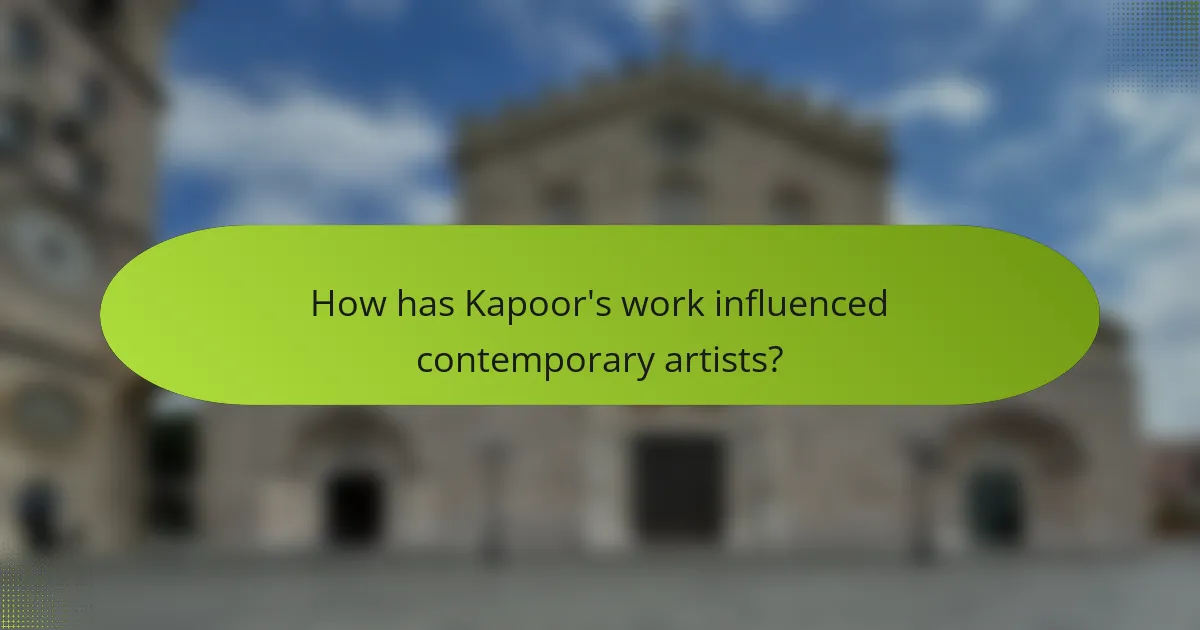
How has Kapoor’s work influenced contemporary artists?
Anish Kapoor’s work has profoundly influenced contemporary artists by redefining sculpture’s relationship with space and sensory perception. His innovative use of materials and forms invites viewers to engage physically and emotionally with art.
Kapoor’s iconic installations, such as “Cloud Gate,” challenge traditional boundaries and encourage exploration of scale and reflection. This has inspired artists to experiment with similar concepts, fostering a new generation focused on immersive experiences.
Moreover, Kapoor’s approach to voids and surfaces has led to a greater appreciation for the interplay between absence and presence in contemporary art. Artists now often incorporate these themes, pushing the limits of viewer interaction.
As a result, Kapoor’s influence extends beyond aesthetics, prompting discussions about the role of art in shaping human experiences and perceptions in public spaces.
What are the key artistic movements inspired by Kapoor’s approach?
Key artistic movements inspired by Anish Kapoor’s approach include Minimalism, Land Art, and Installation Art. These movements emphasize space, sensory experience, and viewer interaction.
Minimalism focuses on simplicity and form, often using large-scale sculptures that echo Kapoor’s work. Land Art integrates natural landscapes, similar to Kapoor’s environmental installations. Installation Art invites viewer participation, reflecting Kapoor’s immersive experiences.
Each movement showcases a unique attribute of Kapoor’s influence, enhancing contemporary art’s exploration of space and perception.
How do critics and audiences perceive Kapoor’s contributions to the art world?
Critics and audiences largely appreciate Anish Kapoor’s contributions to contemporary art for their innovative use of space and sensory experience. His sculptures often evoke strong emotional responses and challenge perceptions of form and material. Critics highlight his ability to blend physicality with conceptual depth, creating works that invite viewer interaction. Audiences frequently express admiration for the immersive quality of his installations, which transform environments and engage the senses. Kapoor’s unique approach, particularly in pieces like “Cloud Gate,” demonstrates his skill in redefining public art and enhancing communal spaces.

What best practices can be gleaned from Anish Kapoor’s artistic philosophy?
Anish Kapoor’s artistic philosophy emphasizes the transformative power of space and sensory experience. His best practices include engaging viewers through immersive environments, utilizing reflective materials to alter perception, and exploring the interplay between light and shadow. Kapoor’s focus on emotional resonance invites introspection and challenges conventional boundaries in contemporary art. This approach fosters a deeper connection between the artwork and the audience, enhancing overall engagement.
How can emerging artists incorporate Kapoor’s techniques into their own work?
Emerging artists can incorporate Anish Kapoor’s techniques by exploring the interplay of sculpture, space, and sensory experience. They should focus on materials that evoke emotional responses and create immersive environments. Utilizing reflective surfaces can enhance viewer interaction, while experimenting with scale can alter perceptions of space. Additionally, integrating light and shadow can deepen the sensory experience, inviting audiences to engage with the work on multiple levels. By embracing these elements, artists can create unique pieces that resonate with Kapoor’s innovative approach.
What common mistakes should artists avoid when exploring sensory experiences in their art?
Artists should avoid common mistakes like neglecting audience perception, overcomplicating sensory elements, and failing to balance space and form. These errors can detract from the intended sensory experience. Ensuring clarity in the interaction between sculpture and viewer enhances engagement. A focus on the unique attributes of materials, like Anish Kapoor’s use of reflective surfaces, can create profound sensory experiences.
